Montana has the lowest elevation of all the western U.S. states (3,400 ft/1,036 m on average), but is home to one of the largest mountain ranges in the world – the Rocky Mountains. As a result, Montana’s mountains look especially tall.
For example:

The rocky ridgelines of Granite Peak and the permanent snowfields on Whitetail Peak are a delight to gaze upon. They remind of past eras when tectonic plates pushed the earth’s crust into the skies and centuries of glacial movements carved out the valleys below. Some are sacred to native tribes and the alpine meadows of marigolds and mountain bluebells at their bases are ideal for picnicking.
Many are located in remote areas of Montana’s wilderness, only accessible via long and challenging routes, for experts only. Others are visible from a nearby road. And one of them is accessible via a tram that takes you straight to the top – no climbing needed.
But which are the most stunning ones?
This depends on personal preference, but here is our list of 20 Montana mountains that we think are absolutely stunning – and may arguably be the most beautiful.
20 most stunning mountains in Montana
- Granite Peak
- Mount Wood
- Castle Mountain
- Whitetail Peak
- Silver Run Peak
- Castle Rock Spire
- Tempest Mountain
- Mount Peal
- Beartooth Mountain
- Glacier Peak
- Spirit Mountain
- Mount Inabnit
- Hilgard Peak
- Mount Cowen
- Crazy Peak
- Lone Mountain
- Tweedy Mountain
- Gallatin Peak
- Electric Peak
- Garfield Mountain
These 20 Montana mountains are also the 20 tallest mountains in Montana. Three mountains – Tumble Mountain (14th), Mount Douglas (15th), and Two Sisters (18th) – belong on this list, though we excluded them for lack of information.
GRIZZLY ALERT: No matter where you go exploring in Montana’s outdoors, always bring bear spray and bear bells with you to protect yourself. What are bear bells? Do they even work? – Click here to find out.
1. Granite Peak (Also the tallest mountain in Montana)

Granite Peak is everything a Montana mountain should be – devastatingly beautiful, with jagged rock outcroppings down its slopes and a knife-edge ridge descending from the peak. It’s set in one of the most beautiful mountain ranges in Montana – the Absaroka-Beartooth. It’s also the tallest mountain in Montana at 12,799 ft (3,901 m) and is appropriately nicknamed “The Roof of Montana”.
It’s also one of the most famous mountains in Montana. Mountaineers attest that Granite Peaks is not only a feat to look at, but a feat to climb as well – they consider it the second most challenging high-point summit after Alaska’s Denali. Today, climbers usually spend two to three days climbing the peak via the Froze-to-Death Plateau.
Granite Peak is visible from many places throughout southwest Montana, such as from the Beartooth Pass Scenic Highway – one of the most beautiful Montana mountain passes, and an excellent place for stargazing in Montana – or from Zimmerman Park in Billings.
Quick facts:
- Nickname: Roof of Montana
- Elevation: 12,804 ft (3,903 m)
- Vertical (prominence): 4,500 ft (1,372 m)
- Mountain range: Beartooth Range
- Location: Southwest Montana, near Red Lodge
- Difficulty: Extreme
2. Mount Wood
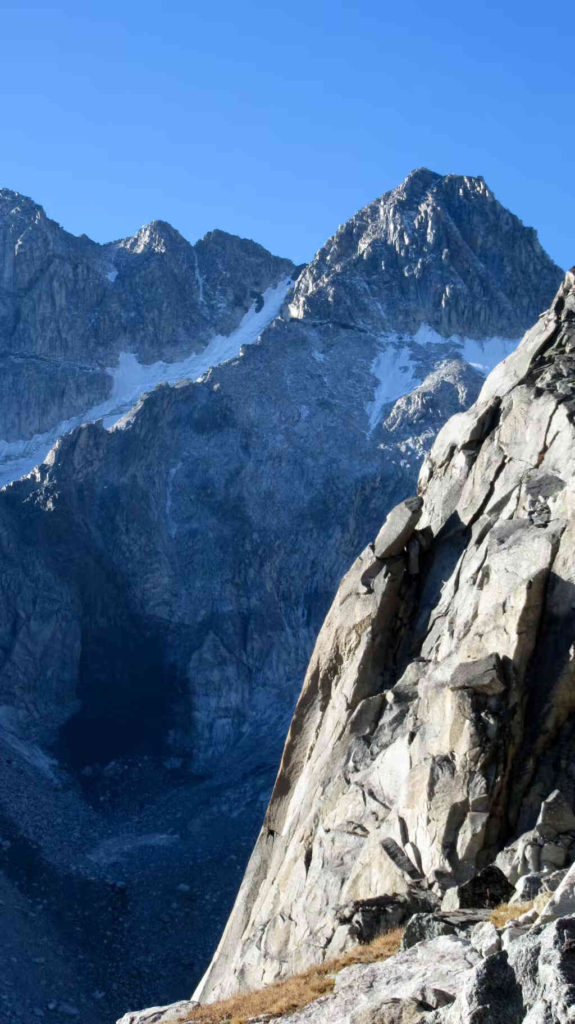
Mount Wood is another one of the Montana mountain gems offered up by the Beartooth Range, the same range in which Granite Peak is located. Mount Wood is just 150 ft (46 m) shorter than Granite and towers over Mystic Lake, a pristine alpine lake and backpacking destination. Gazing up that this giant from the bottom leaves you breathless, though it’s challenging to reach.
There are several routes up this Montana mountain; however, they are quite challenging – even the easiest route entails a strenuous hike up steep slopes and some bushwhacking.
From the top, the views are spectacular – the north side of this Montana mountain is draped in permanent snowfields and Granite Peak is visible to the south. Silver Run, the Castles (Castle Rock, Castle Peak, Castle Rock Spire), Whitetail, and Snowbank Mountains are also visible from the top.
Interesting fact: Mount Wood has two distinct summits. However, no one has confirmed which one is higher.
Quick facts:
- Elevation: 12,660 ft (3,859 m)
- Vertical (prominence): 2,860 ft (872 m)
- Mountain range: Beartooth Range
- Location: Southwest Montana, near Red Lodge
- Difficulty: High
3. Castle Mountain

Castle mountain sits dominantly among the Castle Mountains in the Beartooth Range of southern Montana. As the name suggests, this peak has a castle-like appearance when viewed from the west fork of Rock Creek (from the east). Its sheer vertical walls rising from the valley floor resemble an enormous natural castle.
This is one of the burliest, sturdiest, and most impressive Montana mountains. The top consists of a long ridge running north-south, with bulging rock formations and couloirs running down either side. At its base on the east side (in the west fork of Rock Creek) lies the pristine Omega Lake.
There are several routes up Castle Mountain, but two of the most popular routes start from the west fork of Rock Creek. If you decide to climb or backpack in this area, remember to always hang your food far from camp and carry bear bells and bear spray with you.
Quick facts:
- Elevation: 12,617 ft (3,846 m)
- Vertical (prominence): 2,652 ft (808 m)
- Mountain range: Beartooth Range
- Location: Southwest Montana, near Red Lodge
- Difficulty: High
4. Whitetail Peak
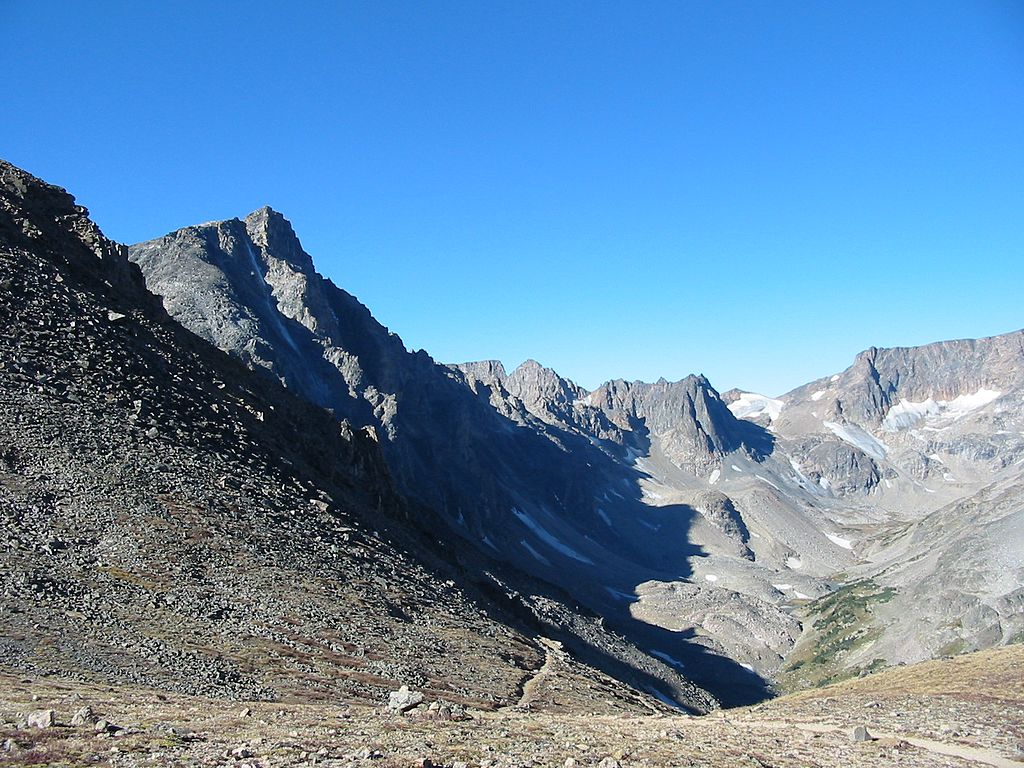
Whitetail Peak is another quintessential peak – jagged and prominent, rising from the valley floor of the west fork of Rock Creek. Its name comes from a distinct, snow-filled couloir that runs the length of the mountain from peak to valley. Whitetail mountain sits in a stunning setting of other jagged peaks and mountain lakes.
If you’re looking to catch a view of a stunning Montana mountain that is impossible to miss, then Whitetail mountain is for you. The view of Whitetail Mountain from the north is especially intimidating.
Quick facts:
- Elevation: 12,551 ft (3,826 m)
- Vertical (prominence): 1271 ft (388 m)
- Mountain range: Beartooth Range
- Location: Southwest Montana, near Red Lodge
- Difficulty: High
5. Silver Run Peak
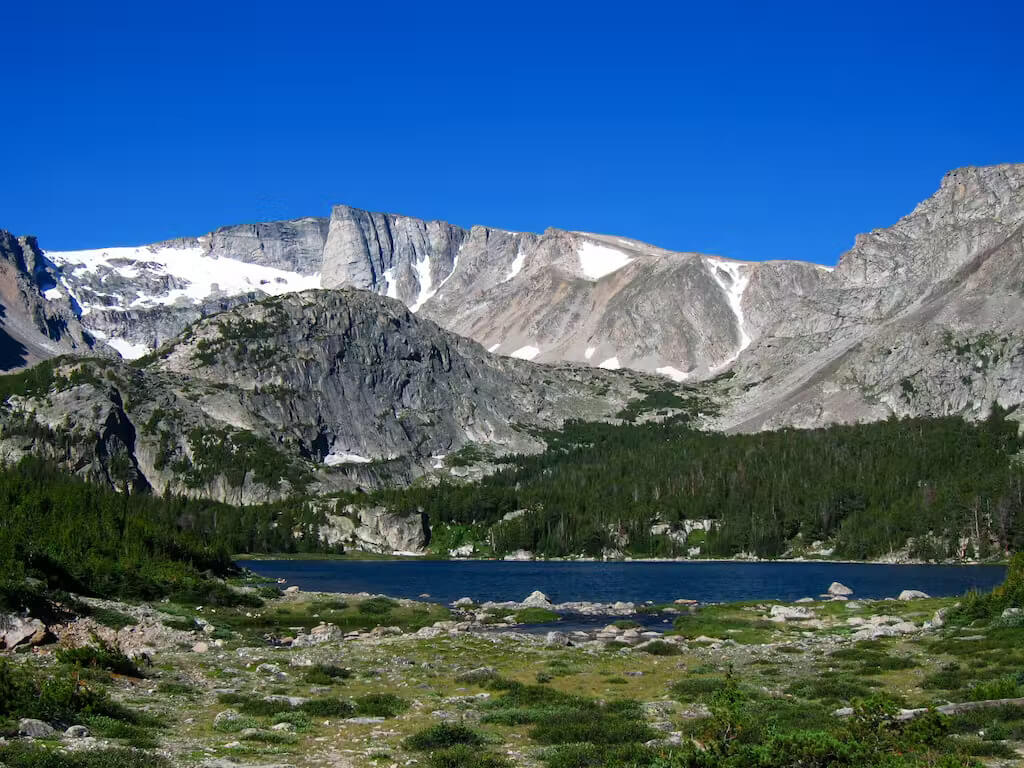
Another darling of the Beartooth Range. Silver Run Peak is the culmination of the extensive Silver Run plateau, which expands across the Beartooth Range for 12 miles and consists of two separate arms. Both arms extend for long distances above 10,000 ft (3,048 m) and feature several slightly smaller peaks.
The top of the Silver Run Plateau is one of the most unique places in the state. As you ascend over the crest of the plateau, you enter a treeless expanse of vast tundra and several rocky peaks. The trail eventually disappears, replaced by rock cairns marking the way.
From the summit, you can get a sense of the incredible power of the glacial movements that carved out the valleys below, shaping this mountain range into what we see today. Permanent snowfields sit at the base of nearby Castle Mountain four miles west.
Routes
There are several routes up this Montana mountain. The easiest, and a very popular one, is from Sundance Pass up a 10.6 mile (17 km) hiking trail. You can find other more challenging, trailless routes and climbing routes on the west face of Silver Run Peak – a drop of 3,000 ft (914 m) to the West Fork valley below.
Quick facts:
- Elevation: 12,542 ft (3,823 m)
- Vertical (prominence): 1,505 ft (459 m)
- Mountain range: Beartooth Range
- Location: Southwest Montana, near Red Lodge
- Difficulty: Moderate to High, depending on the route
6. Castle Rock Spire

Castle Rock Spire is in a remote location of the Beartooths that is rarely visited by anyone. The name does this peak justice – it’s a jagged, picturesque spire surrounded by other notable peaks of the Beartooths, and offers expansive views of nearby Montana mountains.
Directly adjacent to Castle Rock Spire is “Point 12,540” – a peak of roughly the same height (one report indicates that it’s a bit higher than Castle Rock Spire), with a wide, flat top. Together, the pair stand tall and sturdy.
Castle Rock Spire is one of the most difficult and remote Montana mountains, and only experienced climbers should attempt to climb it.
Quick facts:
- Elevation: 12,540 ft (3,822 m)
- Vertical (prominence): 310 ft (95 m)
- Mountain range: Beartooth Range
- Location: Southwest Montana, near Red Lodge
- Difficulty: Extreme
7. Tempest Mountain
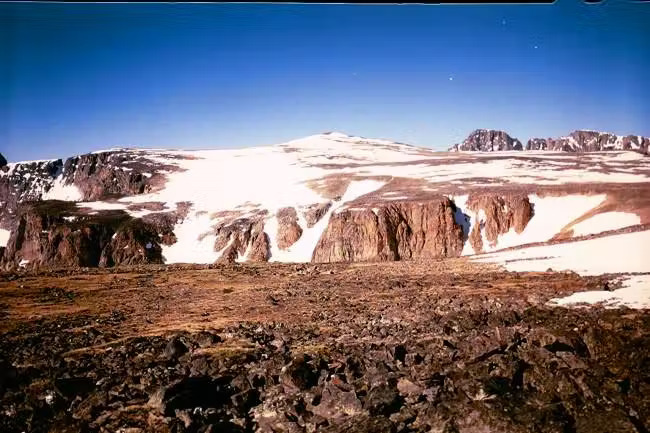
Tempest Mountain is another one of Montanas’ mountains that is a gradual slope on one side but is jagged and cliffy on the other. Tempest mountain is Granite Peak’s closest neighbor to the east (within 1 mi, 1.6 km) and offers expansive views from the top into the glacier-carved valleys and cliffs below.
The landscape on the approach to Tempest Mountain is a treeless realm of rolling tundra, marked by sheer cliffs of hundreds of feet on its sides.
Unfortunately, it’s not a common destination for casual visitors who don’t have climbing experience. Climbers approach this Montana mountain from Avalanch Lake or Froze-to-Death Plateau, and both routes entail significant challenges. The approach from Avalanche Lake involves boulder hopping and a slower ascent, while the route through Froze-to-Death Plateau climbs 3,000 ft (914 m) in roughly two miles at one point, which can cause altitude sickness before even reaching the peak.
Quick facts:
- Elevation: 12,486 ft (3,806 m)
- Vertical (prominence): 909 ft (278 m)
- Mountain range: Beartooth Range
- Location: Southwest Montana, near Red Lodge
- Difficulty: Moderate to high, depending on the route
8. Mount Peal

Another one of the Beartooth Range’s beauties, and located near the others on this list as well. Mount Peal sits just southeast of Tempest Mountain.
If you’re one of the adventurous souls who sets off to climb this Montana mountain, you’ll be in for a splendid journey through the Turgulse Lake Basin. Here, you’ll pass a series of pristine mountain lakes flanked by the walls of rising mountain peaks on either side, such as Mount Hole-in-the-Wall, Tempest Mountain, and Mount Peal. Permanent snowfields sit in some of their coulees.
The approach and onward climb up Mount Peal are best suited for experienced climbers. Unfortunately, hiking this Montana mountain is not suitable for casual visitors.
Quick facts:
- Elevation: 12,409 ft (3,782 m)
- Vertical (prominence): 489 ft (149 m)
- Mountain range: Beartooth Range
- Location: Southwest Montana, near Red Lodge
- Difficulty: High
Discover the 10 Largest Ranches in Montana
9. Beartooth Mountain

Beartooth Mountain is the namesake of the mountain range in which it’s located – the Beartooth Range. Twenty-three features in this region don the “Beartooth” label, a name that originates from the native Crow tribe of Montana. Crows call the striking toothlike spire in this range “Na Pet Say”, or the “Bear’s tooth” (center in the above image).
The “Bear’s Tooth” spire sits east of Beartooth Mountain (left in the image). Both are visible from the scenic Beartooth Highway, which leads from Red Lodge to Yellowstone National Park. The Beartooth Scenic Highway is one of the best ways to explore the Beartooth Range, where you can see treeless tundra, wildlife, and the tallest mountains in Montana.
Quick facts:
- Elevation: 12,351 ft (3,765 m)
- Vertical (prominence): 1,471 ft (449 m)
- Mountain range: Beartooth Range
- Location: Southwest Montana, near Red Lodge
- Difficulty: High
Are you interested in prehistoric times? This Montana wildlife refuge held a secret beneath its soil – dinosaur fossils
10. Glacier Peak
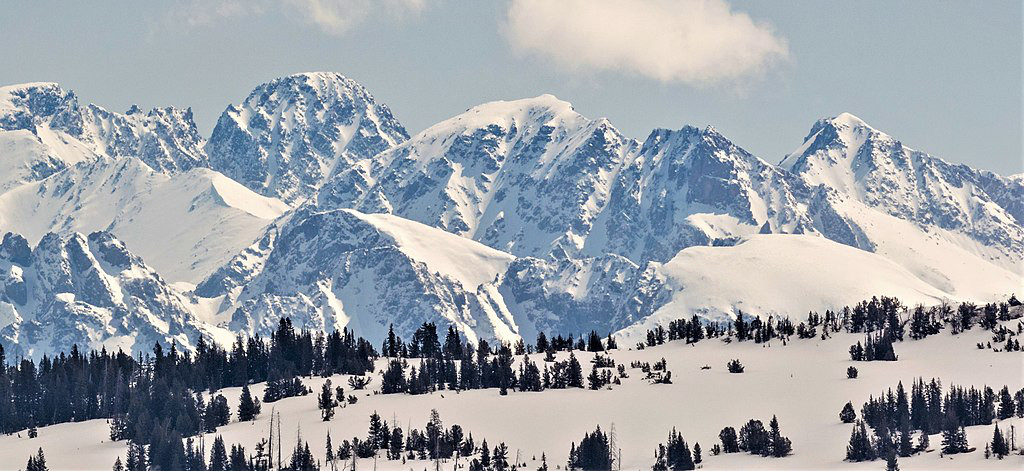
Glacier Peak’s unique features draw a lot of attention – a prominent peak draped by jagged rock outcroppings, cliffs, and couloirs all down its north face. A glacial remnant clings to the base of Glacier Peaks’ north face, called Hidden Glacier.
Glacier Peak sits just west of Granite Peak, the tallest mountain in Montana, and even closer to Mount Villard, which is located just down Glacier Peak’s east ridge. This horizon of Montana mountains makes for a breathtaking sight, especially when covered in snow.
Climbing Glacier Peak is a feat mainly for very experienced mountaineers that entails several thousand feet of elevation gain in just a couple of miles.
Quick facts:
- Elevation: 12,340 ft (3,761 m)
- Vertical (prominence): 800 ft (244 m)
- Mountain range: Beartooth Range
- Location: Southwest Montana, near Red Lodge
- Difficulty: High
Discover 10 weird and wonderful things Montana is known for
11. Spirit Mountain
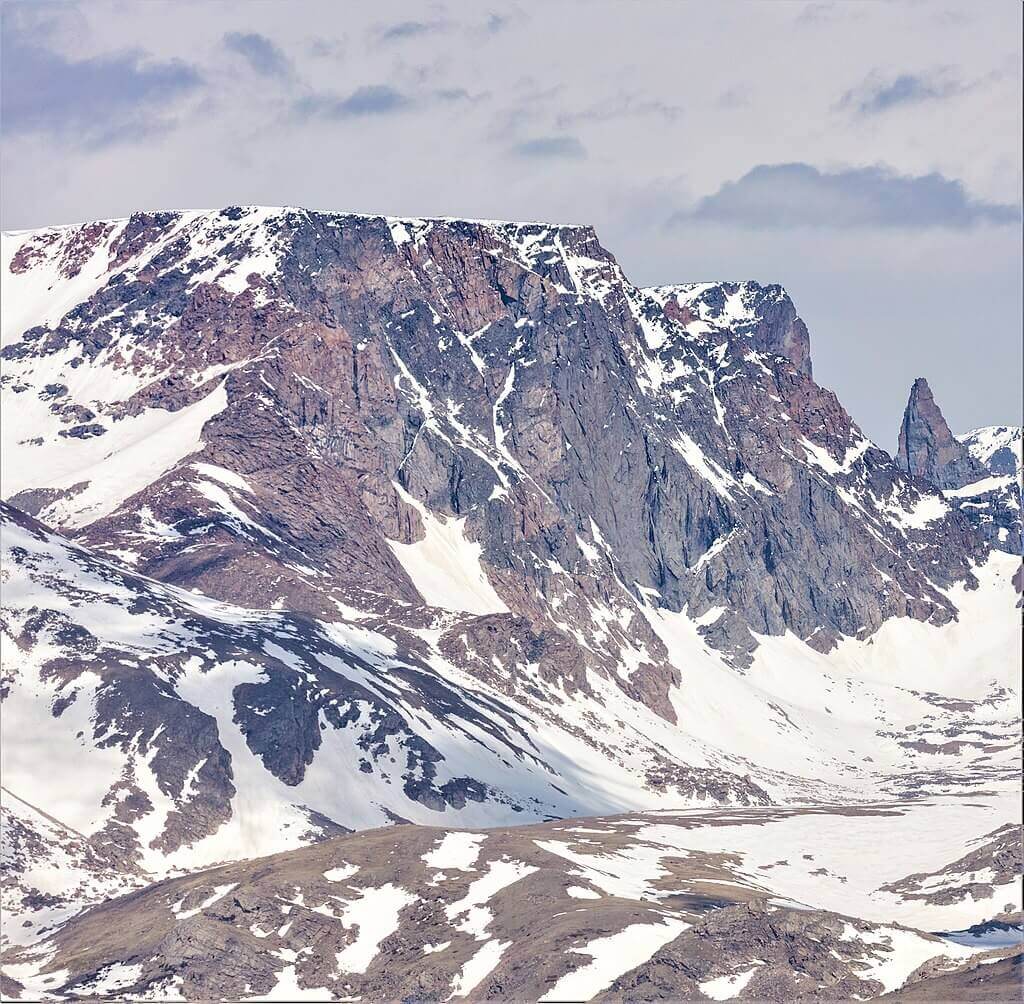
Spirit Mountain is a unique beauty of the Beartooth Range. This Montana mountain’s distinct, wide shape and flat top with steep, jagged faces give it a strong presence and make for stunning scenery. It’s surrounded by a beautiful landscape – the result of glaciation that took place in this region about 1.6 million years ago.
The glacial bodies of that time left several flat-topped peaks untouched, many of which are visible from the top of Spirit Mountain. This glacial activity carved out canyons and sheer cliffs – the distinct landscape surrounding the mountains of this region.
Interesting fact: The Salo family placed a plaque atop the Spirit Mountain summit in 1994 commemorating their climb to the top of what they call “Mount Salo”. The plaque was removed in 2005, in line with the USFS’s policies for unofficial plaque placements. A mountain 7 miles northwest of Spirit Mountain dons the name Salo Mountain, so there remains some confusion about whether or not one of these mountains was named after the Salo family, and which one it might have been.
Quick facts:
- Elevation: 12,283 ft (3,744 m)
- Vertical (prominence): 763 ft (233 m)
- Mountain range: Beartooth Range
- Location: Southwest Montana, near Red Lodge
- Difficulty: High
12. Mount Inabnit

Mount Inabnit is a stellar Montana mountain in one of the most hard-to-reach areas of the Beartooth Range, and its isolation adds to its beauty. Due to its remote location, people rarely visit Mount Inabnit, though a cairn at its summit is one of the few pieces of evidence that this Montana mountain has been climbed. It is one of the most stunning mountains in Montana.
It was named after a man named Fred Inabnit, who was a pioneer explorer of the Beartooth Range and hand-crafted the Inabnit Map, the first map of this area that showed the topography of the Beartooth, Absaroka, and Teton Ranges.
Inabnit was also a pioneer involved with the first attempts to summit Granite Peak. A plague bearing his name was bolted into a large rock at the lower of the Snow Lakes at the base of Mount Inabnit in 1929, though it has since been relocated to the East Rosebud Trailhead.
Quick facts:
- Elevation: 11,928 ft (3,636 m)
- Vertical (prominence): 486 ft (148 m)
- Mountain range: Beartooth Range
- Location: Southwest Montana, near Red Lodge
- Difficulty: High
Do you like visiting small towns? Discover Cut Bank Montana – One of Montana’s prettiest small towns
13. Hilgard Peak
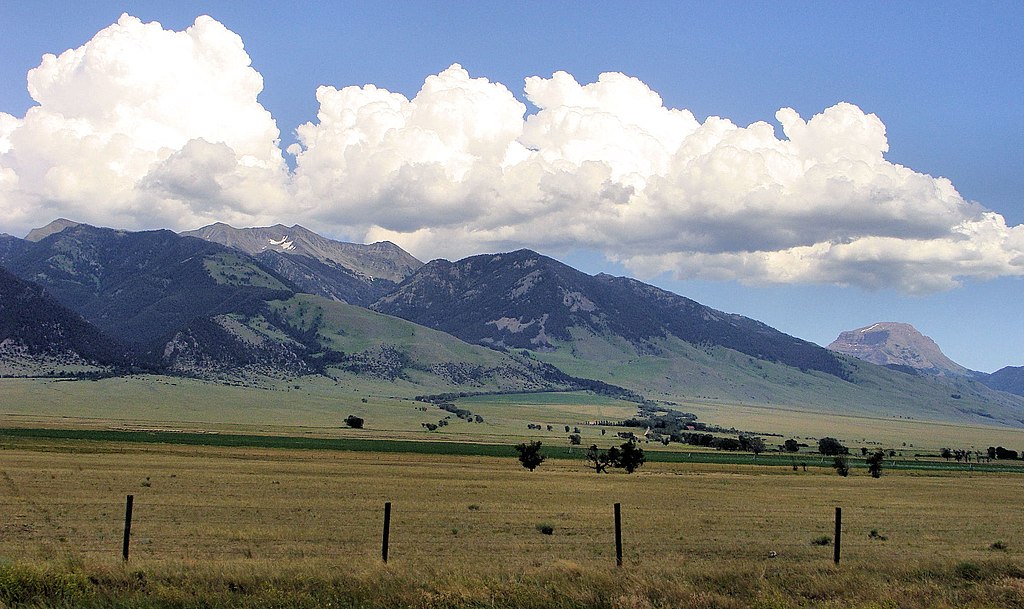
Hilgard sits among the beautiful Madison Range. It is the tallest peak of the Madison Range and the tallest peak outside the Beartooth Range.
Mount Hilgard is also located in the Lee Metcalf Wilderness, and the area surrounding it is home to a range of wildlife, such as black bears, elk, and grizzly bears. It looms over the dark forested mountainsides and rolling grass hills below. Expansive alpine meadows of the area feature marigolds, mountain bluebells, and glacier lilies.
It’s difficult to reach and it’s hard to catch a glimpse of this stunning peak from a nearby road. Nonetheless, we included it in this list because it is one of the most beautiful and tallest Montana mountains.
Quick facts:
- Elevation: 11,316 ft (3,449 m)
- Vertical (prominence): 4,063 ft (1,238 m)
- Mountain range: Madison Range
- Location: Southwest Montana, near West Yellowstone
- Difficulty: High
14. Mount Cowen
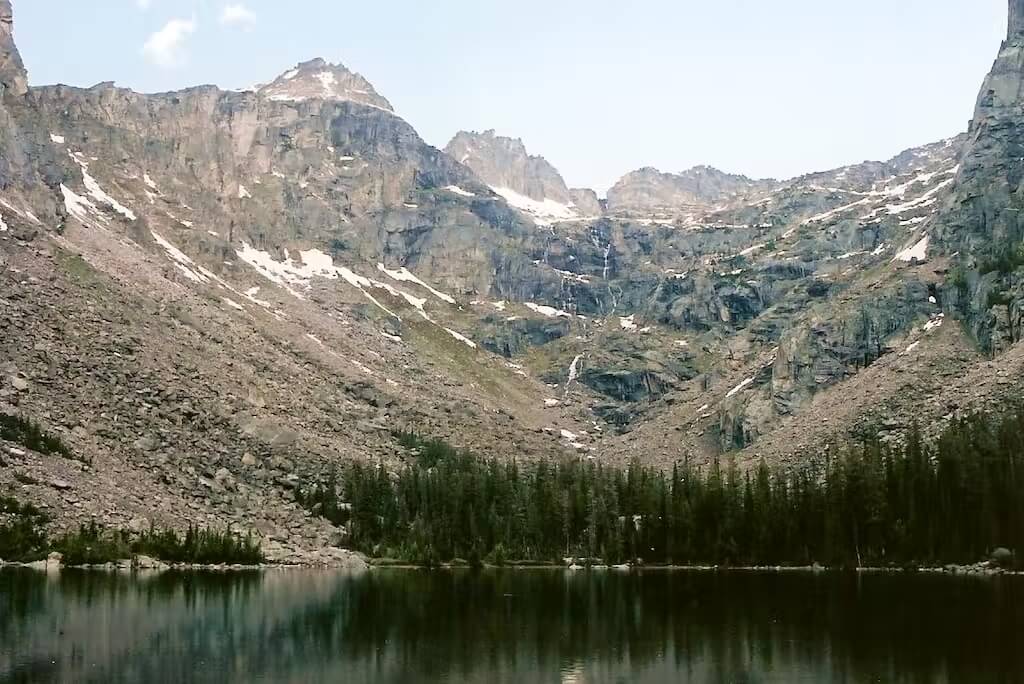
Mount Cowen is another hidden beauty of the Beartooth Range. It’s the tallest mountain of the western Beartooth Range and has a large vertical rise, though it’s hidden behind nearby high ridges. The shortest distance to reach Mount Cowen on foot involves a 10-mile hike (16 km) with about 6,000 ft (1,829 m) in elevation gain.
The Mount Cowen massif (meaning, a compact group of mountains) is composed of solid granite and gneiss, with steep couloirs separating each of the spires of the massif. It’s arguably one of the most stunning Montana mountains.
Mount Cowen peak is surrounded by four satellite spires named Eenie, Meenie, Miney, and Moe. It offers wonderful climbing opportunities for experienced rock climbers and mountaineers.
Quick facts:
- Elevation: 11,206 ft (3,416 m)
- Vertical (prominence): 2,652 ft (808 m)
- Mountain range: Beartooth Mountains
- Location: Southwest Montana, near Paradise Valley
- Difficulty: High
One of Montana’s prettiest valleys – Discover Paradise Valley here
15. Crazy Peak

The Crazy Mountains are a Montana mountain range that’s sacred to the Crow Tribe of Montana, who refer to it in their native tongue as “Awaxawapiia”. It has long been a place of fasting for tribe members.
Legend maintains that Chief Plentycoup spent four days fasting in the Crazy Mountains in Montana, during which time a vision came to him of the bison being replaced by cattle. Once the dream was interpreted, the Crow were instructed to cooperate with those that arrived with the cattle, and not to make war with them. While the Crow tribe lost ownership of this land, the tribe still considers it to be sacred land and maintains a strong connection to it.
Crazy Peak is the tallest peak among the Crazy Mountains and has an incredible 5,709 ft (1,741 m) vertical rise. You can get a nice view of Crazy Peak by exiting I-90 at Big Timber and turning north onto Highway 191. Climbing Crazy Peak is best suited for advanced mountaineers.
Quick facts:
- Elevation: 11,209 ft (3,417 m)
- Vertical (prominence): 5,709 ft (1,741 m)
- Mountain range: Crazy Mountains
- Location: Southwest Montana, near Big Timber
- Difficulty: High
16. Lone Mountain
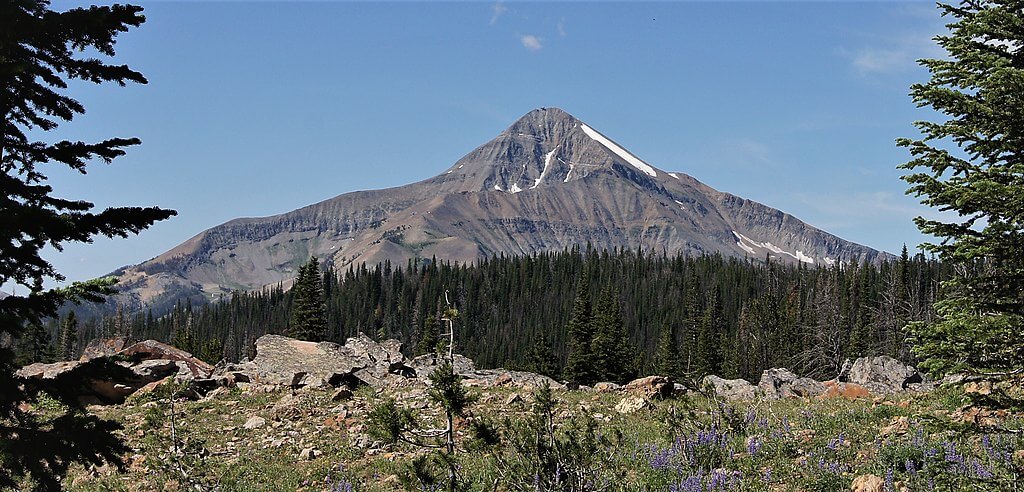
Lone Mountain’s name says it all. This quintessential, prominent Montana mountain is impossible to miss if you’re at Big Sky ski resort. It’s one of the mountains that makes up Big Sky ski resort, and from the Big Sky meadow village, you can see Lone Mountain standing tall and mighty, piercing the big sky with few other mountains in sight. Since it’s part of the Big Sky ski resort, it’s also one of the most famous mountains in Montana.
The south face of Lone Mountain features several wide open chutes and fields that are open to skiers and snowboarders. On the northeast face of Lone Mountain are two distinct, narrow couloirs, also open to skiers and snowboarders.
Ride the tram
Lone Mountain features a tram that takes visitors to the summit, ascending 1,450 vertical feet (442 m) in four minutes over a large bowl, with no support towers between its start and end. There is absolutely no climbing experience necessary here. If you’re interested in catching the view from atop a Montana mountain peak, but you aren’t interested in rock climbing or mountaineering, then you may consider riding the Lone Peak tram.
On the ride up, the tram is suspended hundreds of feet in the air over the couloirs of the northeast face. Keep in mind that a ride up the tram isn’t for those who struggle with heights.
Quick facts:
- Elevation: 11,167 ft (3,404 m)
- Vertical (prominence): 2,722 ft (829 m)
- Mountain range: Madison Range
- Location: Southwest Montana, at Big Sky Ski Resort
- Difficulty: High (No climbing involved if you ride the tram)
Have you ever visited a ghost town? Discover the 10 best ghost towns in Montana
17. Tweedy Mountain
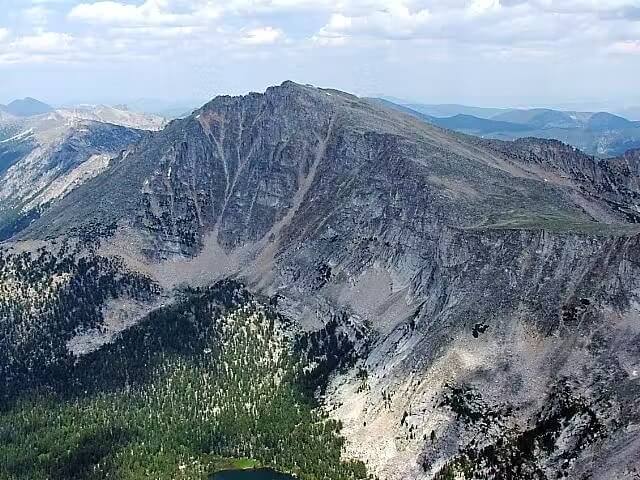
Tweedy Mountain is the tallest peak of the Pioneer Mountains in Montana. Tweedy and its neighbor peak, Torrey, surpass the other mountains of the Pioneer Mountain Range by about 500 ft (152 m).
This Montana mountain features rocky, rugged slopes and a prominent peak. The pristine Barb Lake and Gorge Lakes at the base of Tweedy Mountain make for an ideal resting spot for anyone adventurous enough to hike the extremely challenging route to Tweedy Mountain. The Barb Lake route is trailless.
Tweedy Mountain sits near the delightful town of Dillon, Montana, one of the most pleasant small towns in Montana. Dillon is surrounded by the rolling hills and rivers of the Beaverhead Valley and flanked by the Pioneer Mountains to the west. You can see Tweedy Mountain from I-15 north of Dillon. Approaching and climbing this Montana mountain is best suited for experienced mountaineers.
Quick facts:
- Elevation: 11,154 ft (3,400 m)
- Vertical (prominence): 3,794 ft (1,157 m)
- Mountain range: Pioneer Mountains
- Location: Southwest Montana, near Dillon
- Difficulty: High
18. Gallatin Peak

Gallatin Mountain is the tallest peak in the Spanish Peaks mountain range. It’s a towering, windswept peak in a pleasant region nearby Lone Mountain and the Big Sky ski resort. This Montana mountain has a prominent peak and a thin forest at its base.
From up top, climbers enjoy expansive views of the surrounding basins, peaks, and rocky ridges. This Montana mountain is surrounded by several pristine mountain lakes and streams, such as Chill Lakes, Grace Lake, and Summit Lake.
Quick facts:
- Elevation: 11,015 ft (3,357 m)
- Vertical (prominence): 3,197 ft (974 m)
- Mountain range: Madison Range
- Location: Southwest Montana, near Big Sky Ski Resort
- Difficulty: High
Moving to Montana? Discover the 10 best places to live in Montana
19. Electric Peak
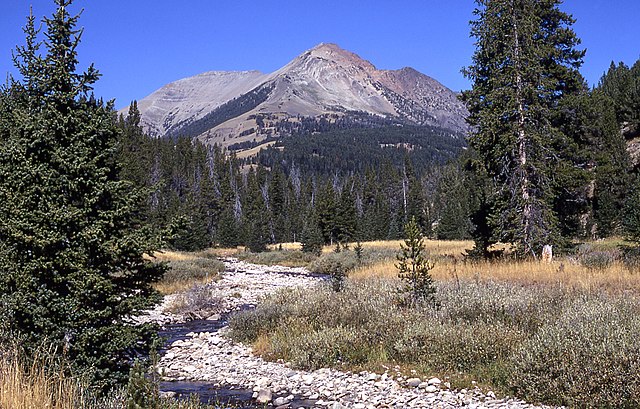
Electric Peak is the tallest mountain in the Gallatin Range of southwest Montana. Its dominating peak pierces the sky. It is draped by rocky, windswept slopes and has a lush forest at its base. The first ascenders of this Montana mountain experienced electrical discharges on their hands and hair, hence the name Electric Peak.
Electric Peak is located in Yellowstone National Park, near Mammoth Hot Springs. While much of the mountain sits in Wyoming, its peak lies on the Montana side of the border. Its enormous vertical rise and towering presence would have you believe it’s the tallest mountain in Yellowstone National Park. However, it’s the 8th tallest peak in Yellowstone.
A common route up this Montana mountain is the Sportsman Lake Trail. However, Yellowstone National Park is notorious for rapidly changing weather – anyone who wishes to approach or climb Electric Peak should be ready for unpredictable weather and bring suitable, warm clothing for the worst of conditions. We only recommend climbing Electric Peak to experienced mountaineers.
Quick facts:
- Elevation: 10,969 ft (3,343 m)
- Vertical (prominence): 3,389 ft (1,033 m)
- Mountain range: Gallatin Range
- Location: Southwest Montana, in Yellowstone National Park, near Gardiner
- Difficulty: High
20. Garfield Mountain

Garfield lies in the unique southwest corner of Montana, a landscape that features rolling, treeless hills, desert sagebrush, and alpine meadows. Birds of prey ride the winds scouring the earth below.
Garfield shares the horizon with three Lima peaks, making for a stunning view from the meadows below. And as with most Montana mountains, the views from the summit are expansive. One climber who reached the top noted in the summit register that they could see the Tetons, one of the most prominent Mountain Ranges in Wyoming.
Getting an up-close view of this Montana mountain entails several miles of driving up mining roads and ATV roads, plus some hiking. If you’re an experienced and dedicated climber and wish to ascend one of the most beautiful mountains in southwest Montana, Garfield is worth considering.
Quick facts:
- Elevation: 10,961 ft (3,341 m)
- Vertical (prominence): 3,281 ft (1,000 m)
- Mountain range: Bitterroot Range
- Location: Southwest Montana, near Lima
- Difficulty: High
See a mistake? Let us know here
Montana mountains – FAQ
Below are answers to some commonly asked questions about Montana’s mountains.
How many mountains are in Montana?
According to the United States Board on Geographic Names, there are 2,991 mountains in Montana, including peaks, buttes, and hills.
What is the major mountain range in Montana?
The major mountain range in Montana is the Northern Rocky Mountains, which runs north-south through the western part of the state. The Rocky Mountain Range of Montana includes 30+ mountain ranges within it, such as the Gallatin Range, Beartooth Range, Madison Range, Absaroka Range, and the Crazy Mountains.
What are the most beautiful mountains in Montana?
Many people who visit or live in Montana enjoy the Gallatin Range, Madison Range, and Absaroka Range for their unique beauty and towering, prominent peaks. The landscape surrounding these mountain ranges consists of rolling tundra, alpine meadows, forested valleys, clear rivers, and mountain lakes, all of which attract many visitors.
There are over 30 mountain ranges in Montana, and deciding which are the most beautiful depends on personal preference.
How tall are the mountains in Montana?
Many of the mountains in Montana reach elevations exceeding 10,000 ft (3,048 m). The three tallest mountains in Montana exceed 12,000 ft (3,658 m) – Granite Peak, Mount Wood, and Castle Mountain. Forty-four other Montana mountains exceed 9,000 ft (2,743 m) in elevation.


